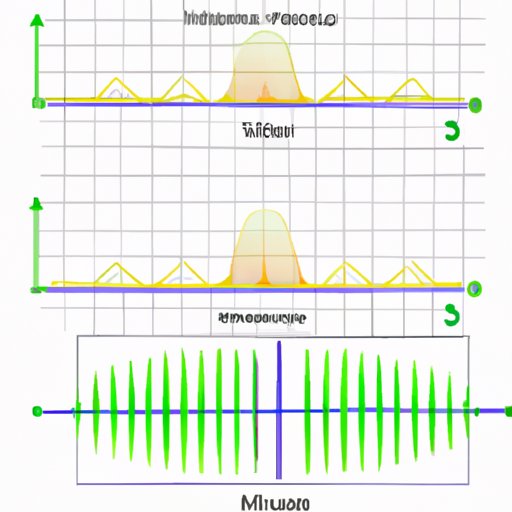Introduction
If you’ve ever used a microwave, cell phone, or a radio, then you’ve used waves with a specific wavelength. Wavelength is a vital property of any wave, and it’s essential to measure accurately in various fields such as astronomy, telecommunications, and medical imaging. In this article, we’ll explore how to find wavelength, its importance, and how to measure and calculate it.
Before we dive into wavelength measurement, let’s define what waves are and their properties. Waves are energy that moves through space or medium, transferring energy from one point to another. Waves have wavelength, frequency, amplitude, and velocity. Wavelength refers to the distance between two consecutive points of similar motion on a wave. The measurement of wavelength plays an essential role in the study of waves and wave-like phenomena.
The Math behind Electromagnetic Waves
Wavelength measurement can be reached through mathematical formulas. The basic formula used to find wavelength is:
wavelength (λ) = wave speed(v) ÷ frequency(f)
Where the wave speed is the distance traveled by the wave per unit of time or velocity, and the frequency is the total number of wave cycles per unit of time.
For example, if you want to find the wavelength of a wave traveling at 300,000,000 meters per second with a frequency of 600,000,000 cycles per second, you would use the formula as follows:
Wavelength (λ) = 300,000,000 m/s ÷ 600,000,000 Hz = 0.5 meters.
Using Spectroscopy to Find Wavelength
Spectroscopy is a scientific method used to study the interactions between matter and electromagnetic radiation. This means it can be used to find the wavelength of electromagnetic radiation by using various spectroscopy techniques such as Absorption spectroscopy, Fluorescence spectroscopy, and Raman spectroscopy.
Absorption spectroscopy measures the absorption of light or other electromagnetic radiation by atoms or molecules to determine the wavelength. Fluorescence spectroscopy looks into the lifetime and intensity of the energy emitted from the excited states of molecules. Raman spectroscopy, on the other hand, measures the inelastic scattering of light by matter to gain info about the energy modes of vibrational and rotational states of molecules.
The equipment used in spectroscopy varies depending on the method used to find the wavelength. Commonly used instruments include monochromators, spectrophotometers, and Fourier Transform Infrared Spectroscopy (FTIR).
Experiment to Measure Wavelength
Scientific experiments are a valuable way to find the wavelength of a wave. Below is a detailed guide on how to conduct an experiment and calculate the wavelength through measuring and calculation.
Materials needed:
– Spring
– Metric ruler or tape measure
– Weights
– Stopwatch
– Calculator
Steps:
1. Hang the spring on a stand.
2. Measure the length of the spring from the hook to the bottom.
3. Add weights to the bottom of the spring.
4. Measure the new length of the spring from the hook to the bottom.
5. Start the stopwatch and gently tap the spring to set it oscillating up and down.
6. Start the stopwatch at the same instant you release the spring.
7. Count the number of oscillations the spring completes in 30 seconds.
8. Use the equation F= (number of oscillations) ÷ (time) Hz to find the frequency of the wave.
9. Solve the equation wavelength (λ)= v ÷ f using the formula in section II to find the wavelength.
The Relationship between Frequency and Wavelength
Wavelength and frequency are closely related. The higher the frequency of a wave, the shorter its wavelength, and vice versa. This relationship can be expressed mathematically as `v = fλ`. v represents the velocity of the wave, f represents the frequency, and, as we previously mentioned, λ represents the wavelength.
For example, the radio waves that you listen to have a frequency of around 100 MHz and a wavelength of approximately 3 meters.
The knowledge of this relationship is crucial in understanding how electromagnetic waves behave and interact with each other.
The Importance of Wavelength in Different Fields
Wavelength plays a crucial role in various fields, including medical imaging, telecommunications, and astronomy. In medical imaging, measuring the wavelength of sound waves is necessary for making ultrasound images. The wavelength of electromagnetic waves plays a critical role in the functioning of telecommunication networks. The radio and microwave frequencies used in cell phones, radios, and television broadcasts all rely on a specific wavelength. In astronomy, the wavelength of light plays a critical role in determining the chemical composition and temperature of stars, planets and exploring the cosmos.
Common Wavelength Units and how to Convert between Them
There are several units of measurement for wavelength. The most commonly used units include nanometers(nm) and meters (m). A nanometer is a billionth of a meter.
To convert between the different units of wavelengths, use the following formulas:
– To convert nanometers to meters, divide by one billion (1 nm = 1 x 10^-9 meters).
– To convert meters to nanometers, multiply by one billion (1 m = 1 x 10^9 nm).
Conclusion
In conclusion, understanding how to find the wavelength is essential in many fields where electromagnetic radiation is involved. This guide has detailed the mathematical and scientific approaches to finding wavelength, including the equipment and methods used in spectroscopy and experiments. We’ve also emphasized the importance of wavelength in different fields such as medicine, astronomy, and telecommunications. Whether you’re a scientist, researcher, or student, understanding how to measure and calculate wavelength is critical in solving wavelength measurement problems.
